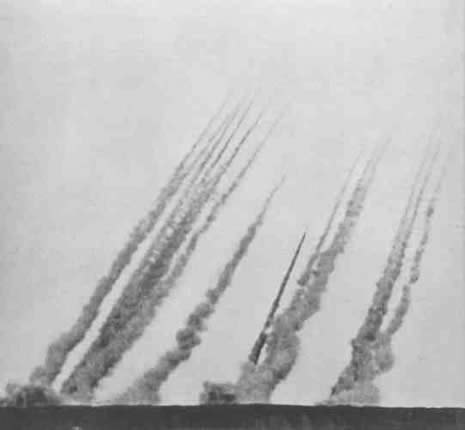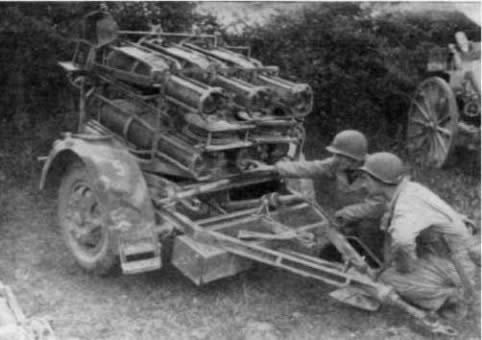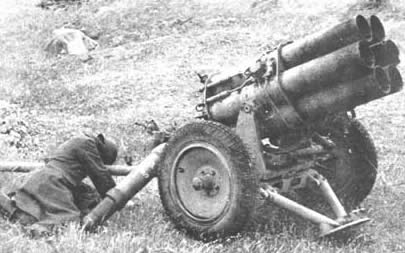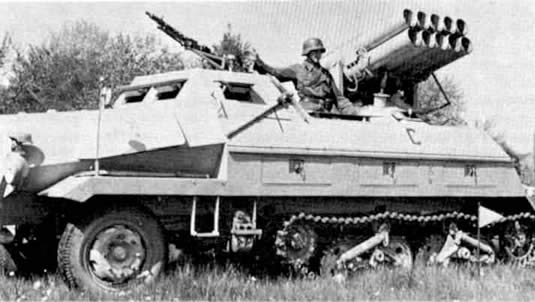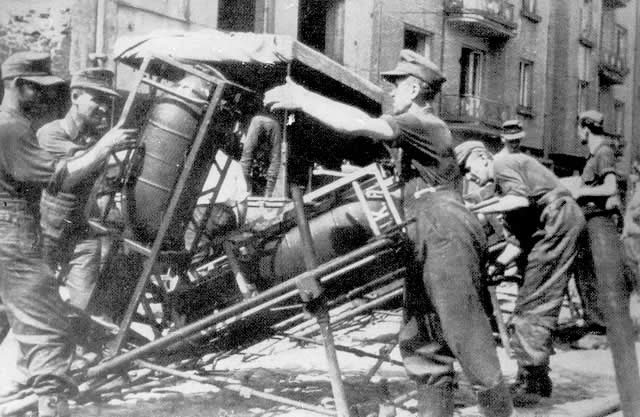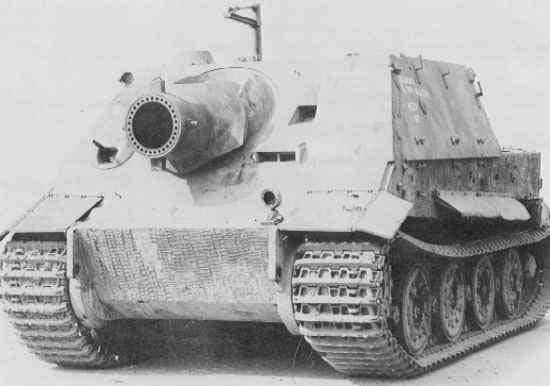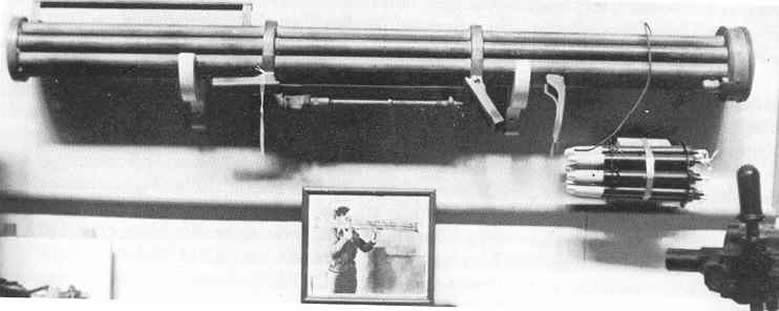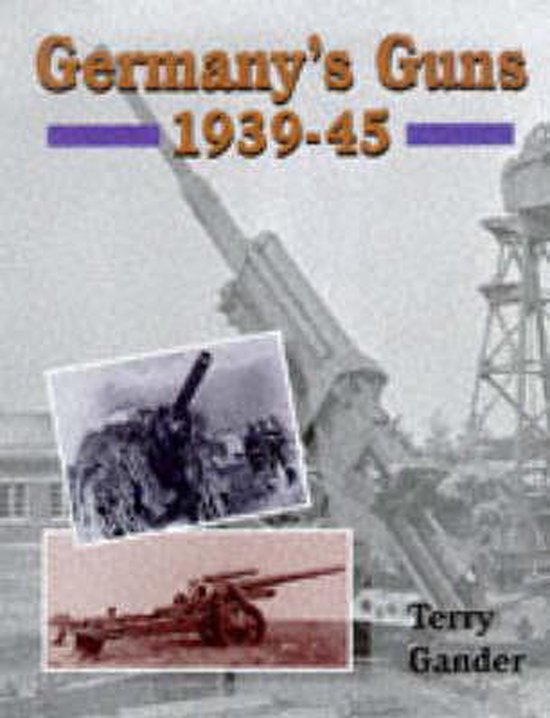Introduction
Using rocket technology to launch projectiles was already possible during the First World War. Previously, the possibility was there but projectiles were unpredictable during launch as well as in flight and hence they were never use in practice. The discovery during the First World War of new solid fuels that burned evenly was the beginning of the development of rockets for military use. During the 20s and 30s, experiments were conducted in and outside Germany with fuels and materials for use in rockets. Pursuant to the Treaty of Versailles, Germany was forbidden to develop long range artillery and so these experiments were either conducted in secrecy or in foreign countries.
In 1931, the German army opened a test location for rocket technology in Kummersdorf-West. The first experiments were low budget and among other things, a 73mm rocket was developed for dropping propaganda leaflets over and behind enemy lines. Exchanges of technology in this field occurred between the Luftwaffe test location in Tarnewitz where investigation was conducted into screens of rockets against low flying aircraft without any success worth speaking of.
In order to gain at least some practical experience, in 1931 the army bought commercial rockets from Fr. W Sander in Wesermünde. In 1934, these rockets were transferred to a training unit as the 11cm Rauchspurgerät equipped with a high explosive warhead. These rockets has a range of 28,8 miles and have never been deployed in operations, at least as far as known.
In all German rocket experiments, rotary stabilization was applied to keep the rocket in its trajectory. The exhaust gasses were expelled at a slight angle to make the rocket rotate to remain stable in flight with little disturbance by side wind or other influences. Stabilization by fins was deemed too simple and too low-tech and was therefore rejected, despite this method being far more easy to produce and claiming less raw materials. This would seriously limit the production of rocket projectiles during the war.
Rockets were not overly accurate as to the place where they struck, hence they were used to bomb vast areas. Rockets were rather stable in the air but propulsion time was a lot less accurate, making their range far from precise. Regarding trajectory and range, rockets were less precise as compared to regular artillery but they were very useful in bombing areas with heavy explosive charges and the cost of production remained very limited, Rockets were therefore considered a good supplement for conventional artillery but never a replacement thereof.
Halfway through the 30s, The German designers focused on two artillery rockets designs, one of 15cm and one of 28/32cm. In 1940, the first production models entered service. The 15cm rocket became the standard rocket of the German army throughout the war. In the beginning, artillery men were not overly enthusiastic about these rockets but in mid-1942, this attitude had changed drastically. The first reason was that German industry couldn't deliver a sufficient number of artillery pieces and so, rockets were deployed out of necessity to fill the gap. The second reason was the effect Soviet Katyusha rockets had on German military. These were fin stabilized rockets of the Red Army which had a particularly strong effect on German troops. The rockets were launched from steel rails in the back of trucks and often in large numbers.
The name Nebelwerfer was usually given only to specialized mortars for laying smoke screens. In the early days of rocket artillery, this name was used as a cover-up for the real task. This name has never been changed later on and so, the term Nebelwerfer wasn't exclusively used for laying smoke screens but for rocket artillery in general.
Definitielijst
- First World War
- Took place from 1914 till 1918 and is also named The Great War. The conflict started because of increased nationalism, militarism and neo-colonialism in Europe. Two alliances battled one another during the 4-year war, which after a dynamic start, resulted into static trench warfare. The belligerents were the Triple Alliance (consisting of Great-Britain, France, and Russia; later enlarged by Italy and the USA, amongst others) on the one hand and the Central Powers (consisting of Germany, Austria-Hungary, Bulgaria and the Ottoman empire) on the other hand. The war was characterized by the huge number of casualties and the use of many new weapons (flamethrowers, aircraft, poison gas, tanks). The war ended in 1918 when Germany and its allies surrendered unconditionally.
- Luftwaffe
- German air force.
- mid
- Military intelligence service.
- propaganda
- Often misleading information used to gain support among supporters or to gain support. Often used to accomplish ideas and political goals.
- Red Army
- Army of the Soviet Union.
- rocket
- A projectile propelled by a rearward facing series of explosions.
15cm rockets
15cm Nebelwerfer 41
The diameter of 15 cm for rocket artillery was chosen as early as halfway through the 30s, together with the 28/32 diameter. The former however became the standard for rocket artillery during the entire war. A 15cm Nebelwerfer consisted of the chassis of a 3.7cm PAK 35/36 with 6 tubes grouped in a circle. The rockets were loaded from the rear and activated by means of an electrical detonator. All six rockets were launched simultaneously, be it with an interval of two seconds in a diagonal pattern - never two side by side - to prevent the metal from being distorted by the heat.
Launching itself was carried out by a control unit from a safe distance. Launching caused a long smoke trail which immediately disclosed the position of a battery or unit. After launching, a change of position was paramount to avoid being targeted by enemy artillery or aircraft. Launching was always accompanied by a high pitched whistling sound which was given various nicknames by the soldiers. Allied military called them Moaning Minnies.
Damage caused by that kind of projectiles was considerable. Explosion took place close to the ground, making the effect of shrapnel and the blast of the explosion extremely effective. The cost of one Nebelwerfer 41 was RM 3,350 against RM 16,400 for one 10.5cm 13FH18. The rockets themselves were far more costly however than the shells of a conventional artillery piece.
The number of rocket artillery units or Werferregimenten increased steadily during the war to 150 in 1945, plus 50 staff batteries and 13 individual batteries. Total production of the Nebelwerfer amounted to 5,769 units and 5,049,780 rockets.
Technical data 15cm Nebelwerfer
| Length of tube: | 4ft |
| Weight in action: | 1,195lbs |
| Elevation: | -5,5 to + 45 degrees |
| Rotation: | 24 degrees |
| Production: | 5.769 units |
Do-Gerät
This was a launching mechanism for a single 15cm rocket, exclusively developed for airborne troops of the Luftwaffe. Only a few test examples have been produced.
15cm Panzerwerfer 42
In order to create more mobility, 10-tube rocket launchers were fitted onto Opel Maultier halftracks. These were introduced in 1943 and up to 1944, 296 units were produced. Of these, there were a number of unarmed vehicles used as ammunition carriers. From the end of 1944 until the end of the war, 10-tube launchers were mounted on Schwere Wehrmachschlepper or heavy tractors, production number unknown. 15cm rockets could also be launched by the 30cm Nebelwerfer 56.
The Luftwaffe also had 15cm rockets in its arsenal such as the 15cm Scheinsignalrakete that were in use as flares to light up the sky. These however were completely independent from the rockets described in this article. In 1944, at least 15 Nebelwerfer 41s have been exported to Finland along with the necessary ammunition.
Technical data 15cm HE rocket
| Weight: | 70lbs |
| Warhead: | 6lbs |
| Length: | 39inch |
| Max speed: | 765mph |
| Range: | 4,3 miles |
Definitielijst
- heat
- High-explosive anti-tank warhead. Shaped charge projectile to punch through armour. Used in e.g. bazooka or in the Panzerfaust.
- Luftwaffe
- German air force.
- rocket
- A projectile propelled by a rearward facing series of explosions.
28/32cm rockets
The 28 and 32cm and the 15cm rockets were developed simultaneously and according to the same principles. The 28/32cm entered service at about the same time as the 15cm and were equipped with rotary stabilization as well. The same engine as the 15cm was fitted but they carried a heavier payload. They were not intended for use as artillery rockets but for the destruction of fortified positions like bunkers and such. They were short range: 1.2 and miles and 1.4 miles for the 28 and 32 respectively.
Schwere Wurfgerät40/41
These rockets were launched straight from their packing crates placed on a launching pad. There were two versions: Schwere Wurfgerät 40 made of wood and Schwere Wurfgerät 41 made of steel. This launching method proved hardly successful and had little tactical value among the troops.
Nebelwerfer 41
The solution for more mobility would have to become the Nebelwerfer 41 which was introduced in 1941. These consisted of six launching tubes mounted on a single-axle chassis; after each salvo, the tubes had to be loaded again. This type also had little success, mainly because the poor accuracy and limited range of the rockets. As a result, only 345 units were produced.
Technical data 28/32cm Nebelwerfer.
| Weight in action: | 3.527 or 3.594lbs |
| Elevation: | 0 to + 45 degrees |
| Rotation: | 30 degrees |
| Production: | 345 units |
Schwerer Wurfrahmen 40
Another launching method was found by mounting launch containers on the sides of vehicles such as the SdKfz 251/1. Various other vehicles were used such as for instance captured French tanks. This system was designated Schwerer Wurfrahmen 40 and provided mobile troops with fast deployment of heavy supporting short range fire against fortified positions.
Luftwaffe
The Luftwaffe did conduct tests with these 28cm rockets by launching them from containers beneath the wings of for instance Junkers Ju-88 and Focke Wulf Fw-109. This wasn't a success because of the short range and poor accuracy. The Soviets made a strange compliment to the German designers though by copying the 28cm rockets and using them as the 28mm M-28 later in the war.
Technical data HE 28 and 32cm rockets
| Type: | 28cm rocket | 32cm rocket |
| Weight: | 183lbs | 174lbs |
| Warhead: | 110lbs | 88lbs |
| Length: | 46.8inch | 51inch |
| Max speed: | 324mph | 324mph |
| Range: | 1.2 miles | 1.4 miles |
Definitielijst
- Luftwaffe
- German air force.
- rocket
- A projectile propelled by a rearward facing series of explosions.
21cm rockets
In order to have a replacement available in case 15cm rockets would fail, 21cm rockets were developed as well. These rockets clearly were a substitute for conventional artillery shells and were well streamlined, greatly increasing accuracy. The rocket made use of rotary stabilization as well to which end 22 angled exhausts were fitted. The explosive charge of the rocket weighed 24lbs and the rocket had a maximum range of 5 miles. The 15cm rocket proved successful but in order to increase the total production of artillery rockets, 21cm additional rockets were ordered and delivered as from 1942.
Nebelwerfer 42
The 21cm Nebelwerfer was an adapted version of the 15cm 41 with 5 instead of 6 tubes. The chassis of the 3,7cm PAK was used for this type as well. The first units were delivered in the course of 1942; they were produced in Donauwörth which turned out 1,487 units and 402,580 rockets until the end of the war.
Technical data| Length of tube: | 4.3ft |
| Weight in action: | 1,212lbs |
| Elevation: | -5 to + 45 degrees |
| Rotation: | 24 degrees |
| Production: | 1.487 units |
Luftwaffe
The Luftwaffe as well conducted various experiments with this rocket being launched from aircraft such as the Messerschmitt Bf 109 G-6/R4, Me 110 F-2, Me 410 A-2 and the Focke Wulf Fw 190 A-4/R6. None of these experiments was successful as they caused a serious reduction in flying characteristics.
Technical data 21cm rocket
| Type: | HE |
| Weight: | 248lbs |
| Warhead: | 23,6lbs |
| Length: | 4ft |
| Max speed: | 716mph |
| Range: | 5 miles |
Definitielijst
- Luftwaffe
- German air force.
- rocket
- A projectile propelled by a rearward facing series of explosions.
30cm rockets
The explosive power of the 28/32cm rockets was highly appreciated, the very limited range and the poor accuracy not at all. Therefore, a 30cm rocket was developed with improved aerodynamics, a comparable explosive charge and a more powerful engine. The warhead weighed 98lbs with a high explosive head. Production started in 1942 but from 1943 onwards, they were produced in sufficient numbers to be used in operation.
30 cm Nebelwerfer 42
This was a direct descendant of the Nebelwerfer 41 with an adaptation to launch the 30cm rockets.
Technical data 42:
| Calibre: | 12inch |
| Weight in action: | 4,100lbs |
| Elevation: | 0 tot + 45 degrees |
| Rotation: | 30 degrees |
| Production: | 380 |
Raketenwerfer 56
In order to simplify production and to have a mobile launch vehicle able to handle various calibres, the Raketenwerfer 56 was developed, based on the chassis of the 5cm PAK 38 from which 6 rockets could be launched. Each unit was delivered with additional rails to enable the vehicle to launch 15cm rockets. Production began in 1944 and reached 649 units.
Technical data
| Calibre: | 12 or 6inch |
| Weight in actin: | 3,825lbs |
| Elevation: | 0 to 65 degees |
| Rotation : | 40 degrees |
| Production: | 649 |
Technical data 30cm rocket
| Type: | HE |
| Weight: | 280lbs |
| Warhead: | 98lbs |
| Length: | 48inch |
| Max speed: | 828mph |
| Range: | 3 miles |
Definitielijst
- rocket
- A projectile propelled by a rearward facing series of explosions.
Other types of rockets
The types of rockets described so far in this article were used the most. There were however more versions and types, either in the design stage or actually produced. These will be dealt with below.
Waffen-SS
Heinrich Himmler's ever growing and increasingly more influential Waffen-SS established its own armament factories and drafted its own weapon designs apart from the army. In this way, a clone was developed and produced of the Soviet 82mm M-8 rocket, the Katyusha. The German clone had a 78mm calibre and was launched from captured Katyusha trucks or from the 8cm R-Vielfachwerfer with 24 of 48 launching rails mounted on captured French Somua halftracks
Kriegsmarine
It also had developed rockets for various applications. For instance, a series of 86mm rockets were produced that could be launched from ships or coastal batteries to light up the sky. In a later stage, these were adapted to carry high explosive charge in order to attack low flying aircraft. Both systems saw very limited operational use.
Another remarkable system was a rocket-propelled depth charge, the so-called Raketen-Tauchgranate. This weapon was installed in limited numbers in suitable locations like the Norwegian fjords. They could fire depth charges in a pattern over a reasonable distance from the coast. This system also stood at the base of the development of the 38cm Raketenwerfer 61 with which the Sturmtiger was armed.
Other rockets
Next to artillery rockets, various other rockets were in use in Germany or being developed. Examples of operational deployment of rockets are for instance the A-4 Vergeltungswaffe 2 or V-2; the Panzerfaust and Panzerschreck. Some interesting or promising projects were under development such as an 8.8cm rocket that could be launched from the shoulder and various anti-aircraft rockets like the 2cm Luftfaust, Taifun and the Rheintochter.
Definitielijst
- Panzerfaust
- German anti-tank gun used by the infantry. Consists of a long tube with the grenade mounted at the front side. It was a disposable weapon. After being used it cannot be reloaded. Major disadvantage is the long flame back blast from the tube.
- rocket
- A projectile propelled by a rearward facing series of explosions.
- Waffen-SS
- Name of Military section of the SS.
Information
- Article by:
- Frank van der Drift
- Translated by:
- Arnold Palthe
- Published on:
- 29-09-2023
- Feedback?
- Send it!
Related books
Sources
Website Panzer-Archive.de
Website Lexikon-der-Wehrmacht
